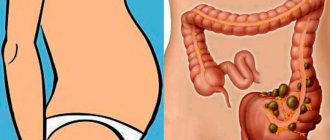What are the warning signs of labor at 39 weeks of pregnancy?
You have been pregnant for almost 9 months, which means that very soon a small miracle will happen and a new person will “replenish” the Earth’s population. The 39th week of pregnancy is the time for emergency childbirth. The child has already taken a position that is most convenient for birth, tucked his arms and legs and tilted his chin to his chest. The fetus at the 39th week of pregnancy is already ready to breathe on its own and take food - mother's milk.
No matter how great the fear of childbirth, 39-40 weeks of pregnancy is the time when most women dream of giving birth quickly. After all, the pregnant belly is already so large that it interferes with normal movement. In addition, women often experience discomfort, their lower back hurts, and their lower abdomen pulls. In a word, this is a difficult period.
Well-being
Let's figure out what happens to the female body at 39 weeks of pregnancy. This is not an easy time, it will require patience and endurance. However, the thought that the trials are coming to an end and there is very little time left before meeting your beloved son or daughter will make it easier to endure the trials.
Since 39-40 weeks of pregnancy is the time for childbirth, the mother’s body is actively preparing for this process. The belly at 39 weeks of pregnancy is very large, most likely it has already moved lower.
This symptom is considered one of the signs of the near end of pregnancy. Abdominal prolapse during pregnancy can occur 1-2 weeks before the onset of labor. But this is optional. For some women, their stomach drops literally on the eve of the birth of their child.
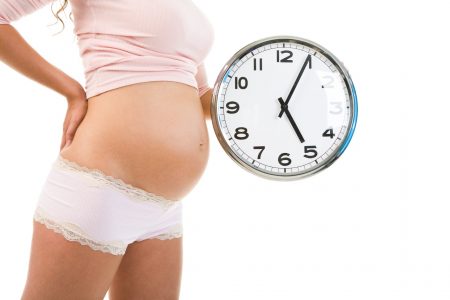
Movements at the 39th week of pregnancy are insignificant; the baby has already grown so much that it is difficult for him to move in such a cramped space. If the baby is positioned correctly, then his head is now directed towards the mother’s pelvic area. If the position of the baby is different, the woman will most likely be placed in a maternity ward, especially if she is indicated for a cesarean section.
Almost all women experience the fact that their stomach becomes stone at 39 weeks of pregnancy. When this symptom appears, you need to understand that these are training contractions or the development of labor. During training contractions there should not be much pain, but there may be a feeling that the stomach is slightly pulling. In addition, training contractions are always irregular.
A child at 39 weeks of pregnancy moves little, but his movements cause significant discomfort. In addition, the uterus has now dropped and is deforming the bladder, so I have to go to the toilet more often than usual.
A prolapsed uterus also affects the pelvic bones, which is why pregnant women often experience lower back pain. There may be pain in the lower abdomen and perineum, but not sharp, but of a pulling nature.

Condition of the "children's place"
The 39th obstetric week of pregnancy is the time when the placenta begins to age rapidly, with:
- its thickness becomes less and less;
- tissue calcification is noted;
- blood vessels begin to function worse.
Because of this, the child receives less oxygen and nutrients. But the process is natural. Nature is wise, and this state of affairs is intended to prepare the baby for the difficult process of childbirth, during which he will inevitably suffer from hypoxia.
However, sometimes the placenta ages prematurely, and the baby is in “starvation mode” for several weeks, which is not good for him. For this reason, in later stages, mothers are often prescribed CTG; this study allows you to check the baby’s well-being.
Ultrasound at the 39th week of pregnancy, as a rule, is not prescribed, since it is not very informative during this period, but if necessary, ultrasound screening can be performed.
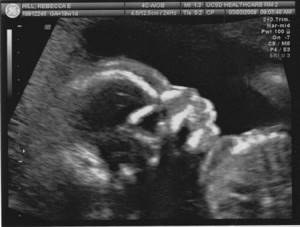
Discharge
Throughout pregnancy, you need to monitor the nature of the vaginal discharge. Normal discharge at the 39th week of pregnancy is moderate, mucous, homogeneous, colorless or the color of milk. Thread-like mucous discharge of white or cream color is not considered a pathology; blood may be present in small quantities in the form of streaks.
The thirty-ninth seven-day period is the time when for many women the mucus plug that covers the cervix comes off. As a rule, the plug comes out a few days before the onset of labor.
At 39 weeks of pregnancy, discharge is considered pathological if it is green (purulent), bloody, curdled or brown.
- White discharge of heterogeneous structure is a sign of thrush. Additional symptoms include severe itching. It is necessary to undergo a course of local treatment (suppositories) to eliminate the risk of infection of the fetus during birth.
Sometimes doctors recommend taking a course of preventative treatment for thrush before giving birth, even in the absence of severe symptoms. As a rule, this is necessary for women whose thrush has worsened several times during pregnancy.
- Yellow-green discharge is a symptom of a bacterial infection. This is a very dangerous symptom, since intrauterine infection of the fetus is possible with the development of severe complications. Therefore, if alarming symptoms appear, you should immediately consult a doctor.

- Bloody discharge at 39 weeks of pregnancy may indicate that placental abruption has begun. Brown discharge may also be a sign of complications. It is especially dangerous if the presence of such discharge causes stomach pain. As a rule, brown spotting appears with partial detachment, and with complete detachment bleeding develops. This is a dangerous complication that threatens both the child and the mother.
- Watery discharge is a sign of amniotic fluid leakage. If such a symptom appears, you should expect the onset of labor to begin soon.
How do symptoms differ in the first and second births?
A woman’s body structure changes after the birth of a baby, so the second pregnancy is easier, and the baby appears faster (according to average data - from three to seven hours), the first appearance of the baby is from six to twelve hours.
The body of a woman who already has children is prepared for the rebirth of a baby, so the warning signs appear seven days before the baby arrives.
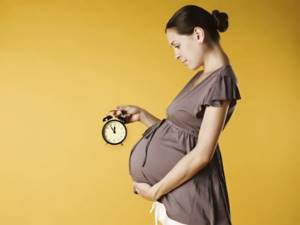
Mothers with many children can feel the birth of a child in a day. If you are expecting your second baby, listen to your feelings from the thirty-fifth to thirty-sixth week. Don't forget that the first stage of labor lasts up to four hours, so hurry to the hospital.
If contractions are frequent, don’t wait - rush to the doctor.
If you decide to have a baby ten years after the birth of your first child, warning signs may appear fourteen days in advance. The fact is that over such a period of time the body is completely restored.
And don’t think that the second birth will be like the first. Everything is individual. Precursors may appear earlier or later when compared with a previous pregnancy.
Precursors of labor in multiparous women after cesarean section proceed as in women with their first pregnancy.
Baby and his development
Pregnancy 39-40 weeks is the final period of gestation. By this time, the child’s development is completely completed and he is ready to be born. The systems of his body are quite ready for an autonomous existence. The baby has all the reflexes necessary for survival. The child now lives in newborn mode, he sleeps most of the day, and during periods of wakefulness he trains his sucking reflex by sucking his finger.
The baby may still be gaining weight. The baby’s body weight depends on heredity and a number of other factors. On average, it is 3.5 kg. But the baby can be born with less or more weight; there are cases when the weight of a newborn reached 5 kg, although such weight, of course, is the exception rather than the rule.
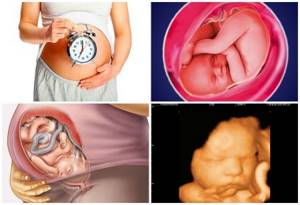
Childbirth
By the last weeks of pregnancy, most women look forward to giving birth, as it becomes increasingly difficult to bear the hardships of their situation. You need to know how to distinguish harbingers from signs of labor.
Harbingers
At the 39th week of pregnancy, the precursors of labor in first-time mothers most likely have already appeared. For many women pregnant with their first child, warning signs appear much earlier - at 36-37 weeks.
But the harbingers of labor in multiparous women may appear literally on the eve of a significant event. In general, the precursors of childbirth in multiparous women and in women expecting their first baby are no different. So, the harbingers of labor at 39 weeks of pregnancy:
- downward displacement of the abdomen;
- discharge of the mucus plug;
- frequent training contractions;
- discharge from the nipples - a thick yellow liquid - colostrum;
- loose stools;
- reduction in body weight.
If you weigh yourself regularly, you will notice that you have lost about 1 kilogram on the eve of giving birth. The fact is that the body gets rid of excess fluid before childbirth.
The appearance of warning signs does not mean that you need to urgently go to the maternity hospital. It may take several weeks from the first signs to appear before the birth process begins.

When is it time to go to the maternity hospital?
Some women prefer to go to the maternity hospital in advance, but most want to wait for the birth at home. If there are no complications, then there is no great need to go to the hospital in advance. How to understand that labor has begun? The following signs indicate this:
- contractions have become stronger, they are repeated at a certain period of time, and this period is becoming shorter and shorter. If contractions occur every 5 minutes, you need to go to the maternity hospital urgently;
- the waters receded - they gushed out or began to leak. In the latter case, the woman will notice that the discharge has become much more abundant and has acquired a liquid consistency.
Characteristic signs of impending labor in multiparous women
The female body is designed wisely. At the end of pregnancy, preparation for the birth process begins. Hormonal changes occur that help facilitate the passage of all stages of the birth of a child. All this contributes to the emergence of precursors of labor in multiparous women. The following become characteristic:
- nervousness;
- prolapse of the abdomen;
- sleep disturbance;
- discharge of the mucus plug;
- periodic contractions;
- breaking of water;
- change in the baby's behavior;
- stool disorders;
- increased mommy activity.
Abdominal prolapse
When does the stomach drop before childbirth in multiparous women? It all starts one or two days before the due date, when the baby descends into the mother's pelvis. Outwardly, this is not always noticeable, especially if the woman is of heavy build. If a palm is placed between mommy’s chest and belly, the belly has dropped. Most likely, mommy will understand this by other symptoms:
- breathing will become easier;
- heartburn will go away - the fetus does not put pressure on the diaphragm;
- Frequent urination will begin due to compression of the bladder;
- lumbago will appear - a short, sharp pain when the child touches the nerves;
- you will have problems sleeping.

There are folk signs on how to recognize the gender of the unborn child by the shape of the belly. Although this can be seen during an ultrasound, women may be curious to compare the results. It is believed that a sharp belly indicates that an heir will be born. If your waist is blurred, and pregnancy is visible even from the back, you are expecting a girl. The belly is wide, looks like a melon and is located high.
- Kishmish grape jam
- How to get rid of wen on the body
- Osteopathy - what it is and what it treats. Descriptions of the technique and indications for making an appointment with an osteopath
Removal of the plug before childbirth
While the baby lives in the womb, it is protected from the environment and infections by a mucus plug. Before childbirth, it moves away, preparing the uterus for the start of labor. Everything can happen in a week, a few days. In some cases, the plug begins to come off during childbirth. In multiparous women, the uterus opens quickly, so this symptom signals that childbirth will occur in a few days.
Precursors of childbirth in multiparous women manifest themselves very individually. You can notice the plug coming off in the shower or toilet. The process can take several days. These will be slimy jelly-like clots. They come out in parts or as a whole piece. By volume - approximately two spoons. The discharge differs in color:
- cream;
- colorless;
- brown;
- streaked with blood.
Cramping pain
About three weeks before labor begins, women experience contractions. They are called training - they prepare the cervix for the upcoming event. Contractions do not cause discomfort or pain. The main thing is that they do not differ in regularity and frequency. Suppositories with papaverine, agreed with your doctor, will help improve your condition. Another thing is regular contractions. Such precursors of labor in multiparous women signal that labor has begun.
A mother expecting her second child does not always remember the specifics of contractions. To distinguish them from training ones, you should know the peculiarities of their course. It is necessary to go to the maternity hospital if:
- loss of amniotic fluid before contractions;
- their appearance at regular intervals;
- reducing the interval between contractions;
- increasing pain;
- increasing the duration of contractions.
Leakage of amniotic fluid
How does the second birth begin? This often occurs with the appearance of precursors - the discharge of amniotic fluid, especially in multiparous women. Everything can happen instantly, without pain. Sometimes the amniotic sac bursts with a dull bang. This can happen at any time. The advice in this case is to urgently go to the maternity hospital, because the situation poses a danger to the baby’s life.
- Rotavirus infection in children
- Pork stew: recipes with photos
- Nematodes in humans - symptoms and treatment. What nematodes parasitize the human body?
Baby's behavior
A harbinger of a prenatal situation is a change in the behavior of the fetus. The baby calms down, it seems that he is preparing to come out into the world. Its head is squeezed in the mother's pelvis, the size of the fetus does not allow active and free movement. This does not mean that movements are completely absent. Mommy must monitor this process, because a limited number of movements indicates a lack of oxygen, which is dangerous for the baby. Just before birth, the baby begins to move actively in preparation for birth.

Nesting instinct
The hormonal changes that occur in the last days before childbirth cause a lot of activity in the mother. This precursor to childbirth is called the nesting instinct. The woman starts cleaning, prepares the room for the baby, and tries to finish the things she started. Everything happens in high spirits. One gets the feeling that she is fluttering around without looking at the impressive size of her belly. She is filled with a feeling of happiness and joy in anticipation of an important event, although she is a multiparous mother.
Stool disorder
Another important harbinger is stool disorder. Before childbirth, hormones are activated that relax the muscles, preparing them for the birth process. The same thing happens with the gastrointestinal tract. Relaxed intestinal muscles cause diarrhea. Constipation at this time is rare. Often everything is accompanied by nausea and vomiting. The body is cleansed and prepared for childbirth. Women are often frightened by this condition, thinking that they have been poisoned. All symptoms indicate that the baby will appear in the next 24 hours.
Other signs of the onset of labor
The expectant mother can find out for herself how labor begins in multiparous women. Harbingers of second birth appear all at once or one at a time. During this period, you need to remain calm, be balanced, observing the changes in the body. You can determine the approaching period in multiparous women by signs. Signals that it’s time to give birth are:
- weight loss;
- lack of appetite;
- the appearance of nausea;
- increased nervousness;
- discharge of colostrum from the breast;
- no swelling;
- difficulty moving;
- pain in the symphysis pubis.
What happens in the body when the fetal head prolapses?
When the fetal head descends, the following occurs:
- the abdominal muscles that support the uterus relax;
- the lower part of the uterus expands;
- the child assumes the position it will have during childbirth;
- the baby's head enters the small pelvis and is pressed against its entrance;
- the uterus descends lower;
- the diaphragm straightens;
- the gastrointestinal tract organs begin to assume their normal position;
- the pelvic bones, legs and bladder take on the burden.
Due to changes in the location of the uterus, a woman’s center of gravity shifts. Due to the load on the lower back, the pregnant woman has to straighten her back and raise her head.
Removal of the mucus plug
The mechanism of how the plug comes off before childbirth in a primigravida is simple. Under the influence of a specific hormone, the cervix expands over time, which is why the mucous secretion accumulated in it is pushed out.
What is a plug during pregnancy?
The birth plug is a natural obstacle that protects the fetus and prevents infection from entering. Immediately after conception, under the influence of hormones, a specific secretion is produced in the lumen of the cervix, which becomes thicker over time. The mucus is pushed out because the cervix becomes wider and more elastic - this is how the plug comes out before childbirth in first-time mothers.
The baby continues to be protected from negative effects by the placenta and amniotic fluid. The passage of the mucus plug in primiparas and those giving birth repeatedly does not mean that the protective barrier is lost.
How does this happen in first-time mothers?
If the expectant mother is a first-time mother, she may not understand how the plug comes out before giving birth. Often the lump is pushed out when going to the toilet. Therefore, many first-time mothers do not see the discharge, feeling only as if something came out from within.
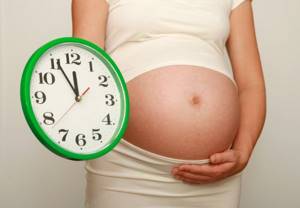
The removal of the plug does not always mean the onset of labor
It is easy to determine that a plug is coming out during pregnancy. The discharge has a characteristic appearance - a dense mucous lump with noticeable bloody inclusions. Sometimes the color of impurities is:
- brownish;
- yellow-white.
This is also a type of norm, so there should be no worries. How long before labor begins during pregnancy after the plug comes out depends on the characteristics of the mother’s body.
Are there any special features for multiparous women?
The discharge of the mucus plug in multiparous women manifests itself with the same symptoms as in those giving birth for the first time. If the interval between the birth of the first child and the second baby is small, the mucous lump often comes out larger because the cervix has become a little wider.
Often, the passage of the plug in multiparous women begins immediately on day “X”, simultaneously with the rupture of the amniotic sac and the release of the fluid surrounding the baby.
Does the plug always come out during pregnancy?
Whether the plug always comes off before childbirth in first-time mothers and those giving birth again is a gynecologist's question. The doctor will answer unequivocally - always, absolutely for everyone. The mucous bolus is produced to protect the fetus from the penetration of pathological microflora and the negative influence of external factors. If a successful mother has no idea what a mucus plug looks like when it is expelled, this means that during rejection she simply did not see the clot. Sometimes the mucous lump in primigravidas and those giving birth is pushed out again during the birth itself.
The answer to the question whether labor can begin without the release of protective mucus is unequivocal - they can: it will simply come out at the time of productive contractions.
Can it come out in parts?
Many pregnant women giving birth to their first or second baby are interested in whether the plug can come off in parts. The lump is most often expelled immediately, but sometimes it separates in parts. In the second case, small portions of discharge are noticeable on the laundry, which contains bloody or yellow-white inclusions.
Usually, before a contraction, you feel tension in the abdominal muscles and slight discomfort. But for many primigravidas, the process occurs without accompanying symptoms.
The main signs of fetal descent into the pelvis
A woman notices a decrease in her abdomen by external signs and internal sensations. External signs:
- the stomach is lowered to the level of the navel so that a palm can be placed freely between it and the chest;
- the gait becomes heavy, the back straightens and leans back.
Internal sensations are expressed in relief of the condition of some parts of the body and increased tension in others. When the fetus drops, the expectant mother feels:
- Easier breathing. The uterus no longer puts pressure on the lung area, so shortness of breath stops.
- Unpleasant sensations in the ribs area disappear.
- When moving, the child does not make strong and painful pushes. It is difficult for a baby who has assumed the prenatal position to make sharp kicks and intense movements.
- Heartburn, heaviness in the stomach, and nausea go away.
- Problems with stool appear. The fetus puts pressure on the rectal area, which affects peristalsis.
- The frequency of urination increases. The expectant mother notes that the strength of the urge to urinate does not correspond to the fullness of the bladder.
- Painful sensations in the pubis, lower back, nagging pain in the upper legs, caused by the pressure of the fetus on the nerve processes.
How can I find out about the process?
Some mothers ask how they can understand that their belly has dropped? Just contact your family, it’s good if they see you rarely, it will be easier for them to compare your stomach today with what it was a week ago.
But if you listen to yourself, you can determine this yourself by the following sensations:
- breathing becomes easier - the uterus no longer puts pressure on the diaphragm;
- no heartburn – the stomach returns to its natural position;
- the woman began to go to the toilet more often - the fetal head puts pressure on the bladder and rectum;
- When walking, there is pain in the perineum.
The folk method will also help. Place your palm between your chest and tummy; if it is completely placed, then your belly has indeed dropped.
Another factor that experienced women often point out is that if your tummy begins to droop, you will not see the usual navel on it. It will go to the bottom. Or it will completely smooth out. What does it look like - a drooping belly? This belly is becoming pear-shaped.
What does it mean - the stomach has dropped, which portends an imminent labor, women will find answers to these and other questions in Olga Pankova’s book “Carrying Pregnancy Correctly.”
For many women, this publication has become a reference book; in it you can find answers to numerous questions about what disorders in the mother’s body can affect the pregnancy of the fetus, what to do with a narrow pelvis and unexpected bleeding.

How soon will labor begin?
The duration of the period between the prolapse of the abdomen and the onset of labor depends on various factors:
- Conditions of the abdominal muscles. In women with weak abs, the stomach drops a few days before giving birth.
- Number of previous births. In first-time mothers, uterine prolapse begins 2–4 weeks before the baby is born. In multiparous women, the stomach drops much later.
- Position of the baby in the uterus.
- Volume of amniotic fluid.
You can understand that you are about to give birth soon if, along with a drooping belly, the expectant mother feels a change in appetite. Women who ate little in the previous period begin to eat heavily. If the pregnant woman had a good appetite, then before giving birth it will worsen.
What determines the size of the abdomen during pregnancy?
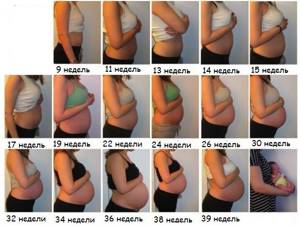
So, from 15 weeks, the uterus leaves the pelvic bones and continues to increase in size and volume. What determines the period at which the belly will be noticeable?
- Woman's Constitution. In thin and short patients, the belly will appear earlier than in tall and plump ones. In pregnant women with the so-called abdominal obesity, when the main layer of subcutaneous fat is located on the abdomen, pregnancy can be a “secret” until childbirth.
- Structures and capacities of the pelvis. The narrower the pelvis of the expectant mother, the earlier the belly will appear and the more voluminous it will look. In tall women with a wide and capacious pelvis, the belly usually appears later and seems smaller than expected.
- Conditions of the muscles of the abdominal wall - the abdominal press. In women who have been involved in sports and have dense muscles of the anterior abdominal wall, the abdomen appears later and looks more compact. In multiparous women or patients who have undergone abdominal surgery, the abdominal muscles are flabby. In this category of pregnant women, the belly appears early and looks large.
- Number of fruits. Definitely, the presence of twins and, especially, triplets in a woman significantly accelerates the growth of the uterus. In mothers expecting twins, the belly is clearly noticeable already at 16 weeks, and already at about 26-30 weeks it has the size of a “full-term” one compared to a singleton pregnancy.
- Volume of amniotic fluid. Polyhydramnios (that is, an increase in the amount of amniotic fluid) in early pregnancy is a relatively rare and prognostically unfavorable symptom. Most often, severe polyhydramnios, leading to rapid growth of the abdomen at 15-20 weeks, is a sign of genetic abnormalities of the fetus or severe infection.
- The presence of space-occupying formations of the uterus, abdominal cavity or pelvis can simulate “abdominal growth”. For example, a large fibroid node or a large ovarian cyst, which sharply begins to grow with the onset of pregnancy, can imitate false growth of the abdomen. The same picture can be given by the accumulation of fluid in the abdominal cavity or ascites. This situation is often observed in women with severe changes in the liver or cancer of the abdominal organs.
To summarize, in pregnant women of normal weight and height, the belly becomes noticeable around 18-20 weeks. In thin patients, the belly may appear at 15-18 weeks. In obese patients, the abdomen may not be noticeable even in the later stages.
When does the belly start to grow during the second and third pregnancy?

During a new pregnancy, many “experienced” mothers remember when the belly appeared during the first one. Sometimes pregnant women are afraid that in the second or third pregnancy the belly has grown faster. In fact, there is some truth in this.
In multiparous women, the belly appears faster and looks more voluminous than in primiparous women with equal fetal weight, weight and height. This is all connected with the same abdominal muscles. During each pregnancy, the muscles of the anterior abdominal wall stretch and become more flabby, especially if the woman does not exercise after childbirth. Therefore, the uterus seems to grow faster. This is only an external deceptive effect, and if you accurately determine the height of the fundus of the uterus, as the doctor does at the appointment, it will be normal.
Alexandra Pechkovskaya, obstetrician-gynecologist, especially for Mirmam.pro
Can labor begin if the belly has not dropped?
Abdominal prolapse is not a necessary symptom of impending childbirth. In some women, the uterus shrinks within a few hours of the start of labor. However, labor can also begin with a high abdominal position. The abdomen may not drop if the following factors are present:
- The fruit is positioned incorrectly. Sometimes the baby takes a transverse position. However, it does not sink into the pelvis.
- Polyhydramnios. With a large amount of amniotic fluid, lowering the baby's head becomes difficult.
- The baby's head is significantly larger than the mother's pelvis. This is possible if the fetus is very large or the mother’s pelvis is small.
- The fetal head at the entrance to the pelvis took on an incorrect tilt. With this arrangement, the likelihood of birth injuries increases, so a caesarean section is necessary.
- Congenital pathologies in a child. For example, hydrocephalus, which externally manifests itself in a pathologically large head size.
The first harbingers of labor in multiparous women
The appearance of false contractions. This symptom is necessary to prepare the expectant mother for the arrival of the baby. False contractions begin to appear in the month of birth. In rare cases they are absent.
In multiparous women, training contractions begin to appear within six weeks. They cause discomfort, but do not cause severe discomfort. The duration is short, the intervals are long, there is no pattern.

But if you notice an increase in the duration of contractions, and they do not stop when you change position and take vitamins, these are harbingers of an early birth in multiparous women. After the second pregnancy, the woman does not experience much pain, so note the time. If the time period is 10 to 15 minutes, go to the hospital immediately.
Fetal development
- By the end of the term, the weight of the fetus should be about 3 kilograms, and the height should reach 50 centimeters. These indicators are individual and are transmitted from the father and mother of the unborn child.
- The digestive, respiratory, immune and other systems of the body are ready to function. The first feces appear in the intestines as a result of the baby swallowing amniotic fluid. They are eliminated from the body after birth.
- The baby’s intestines do not yet have their own beneficial microflora - they will appear with the first portion of mother’s milk.
- The central nervous system is not yet fully developed. She will continue to improve after birth.
- The baby can already hear everything and feel touches on his stomach. He also distinguishes between light and dark times of the day, and he has developed a stable rhythm of life. He reacts to the anxious and calm state of the mother. Stress and excessive anxiety have a bad effect on a child's body.
- The child's eyes can focus at a distance of 20-25 centimeters.
- The fetus began to move less actively, as the space surrounding it became noticeably tighter. At 39 weeks this occurs due to less amniotic fluid. As a rule, the baby has already taken the right position to go outside.
- The sucking reflex, necessary for eating immediately after birth, actively develops.
- The baby's skin is no longer translucent. It has acquired a white tint, and the folds due to weight gain and subcutaneous fat are gradually smoothed out.
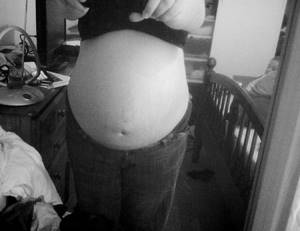
Spending time at home
As a rule, the baby already has hair. Also, a child at 39 weeks of gestation tries to focus his gaze and respond to a color image.
Recommendations for the expectant mother
Final preparations By this time, the expectant mother already knows where she will give birth, as well as who will deliver the baby. She must have all the necessary documents, medications, and things for the trip to the maternity hospital. It is worth carefully planning this day: when contractions begin, is it necessary to call an ambulance or will relatives be able to take the woman by private transport. Long trips at week 39 and long flights are also undesirable. Relatives should always be there to encourage the expectant mother if contractions begin.
Nutrition A pregnant woman may suffer from constipation in the last stages, so you should avoid “heavy” foods and give preference to dairy products, vegetables and fruits. Under no circumstances should you overeat. It is better to eat often, in small portions. You should also continue to take prenatal vitamins during the last trimester.
Emotional state The child is still closely connected with the mother, not only physically, but also emotionally. This connection means that worries and stress, as well as lack of sleep and a nervous state, have a bad effect on the child’s health. Mom needs more positive emotions and to protect herself from worries and stress. When the baby is not yet born, you can afford to go shopping to buy all the things your baby needs.
What happens in the mother's body
- The expectant mother's cervix becomes shorter in order to be ready to open and release the baby.
- The belly drops lower and lower, and the baby is closer to the exit of the uterus.
- At week 39, the mother may feel relief: weight loss, pain in the lower abdomen decreases, swelling of the body ceases to bother, and the lower back stops hurting.
- The mother may experience “training labor” - the uterus begins to contract, pain appears, as during contractions, but these signs do not lead to the onset of labor.
At 39 weeks, a pregnant woman experiences excitement in anticipation of the long-awaited meeting with her child. She worries about how labor will go at 39 weeks of pregnancy and listens to her body:
- the expectant mother feels the baby’s kicks less often, the fetus drops closer to the pelvis, which means that labor may begin soon;
- it becomes easier for a woman to breathe, since the enlarged uterus no longer puts pressure on the lungs and diaphragm;
- discharge mixed with mucus may begin, which means that the mucus plug, protecting the baby from the outside world, has gradually begun to come out;
- A pregnant woman has to run to the toilet more often due to the enormous pressure on the bladder.
How long does it take for the belly to get bigger?
According to gynecologists, the average period for the beginning of abdominal growth during pregnancy is 16 weeks. It is at this time that the uterus in the lower abdomen begins to be felt. With each subsequent week it rises higher and higher, and the reverse process will begin towards the end of pregnancy, when the belly drops before childbirth (about a month in primiparous women and immediately before the onset of labor in multiparous women). But practice often shows exceptions to the rules: the belly can begin to grow in the first month of pregnancy and in the eighth. For some women, it will not be noticeable at all throughout pregnancy.
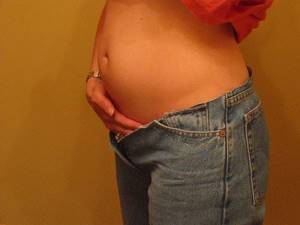
In thin girls, abdominal growth is noticeable several weeks earlier than in plump girls.
All about children
06/30/2019 admin Comments No comments
The 39th week of pregnancy is the home stretch. There is a feeling of relief, it feels like there are only twenty weeks left. It becomes much easier to breathe. Before giving birth, weight will not increase, of course, provided proper nutrition. The baby is fully matured and is full-term, so it is free to be born at any time. Training contractions are becoming more frequent, but they are still as short and do not bother you much. Their main task is to prepare the uterus for real contractions during childbirth.
Fetal development at 39 weeks of gestation
The fetus at 39 weeks of gestation changed its position - it pressed its chin to its knees. He continues to grow, but it becomes very uncomfortable and cramped for him to move. All his internal organs are fully formed and already function like those of an adult. The lungs are ready to open for the first breath.
At this stage, there is a danger that the umbilical cord that feeds the baby may become knotted around his neck. But this situation is usually determined in advance by ultrasound.
Child's weight, height and size
The size of the fetus at the thirty-ninth week of pregnancy resembles a small watermelon. The baby's height is approximately 50 cm. The baby's weight at 39 weeks of pregnancy is about 3 kg. All these indicators, of course, may differ somewhat in reality, depending on heredity. The fluff (lagoon) has almost disappeared. Most toddlers have hairs on their heads.
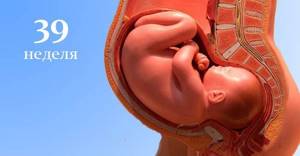
How does a baby develop?
The development of the fetus at the 39th week of pregnancy is almost complete, the baby is still gaining the necessary fat and muscle mass. His skin has become whiter and is no longer translucent.
The digestive system is functioning. Villi have been formed in the intestines, which are already slowly moving the original feces (meconium) to the lower sections. The glands of the stomach and pancreas work fully. The stomach produces enzymes that are needed to process incoming food. Now the digestive tract is completely sterile. Bacteria that help digestion will appear in the esophagus only with the first intake of breast milk.
At this stage, the child develops the main reflex – sucking. When the baby is born and begins to suck milk, he will also develop a chewing reflex. Only after a month will the newborn’s salivary glands begin to function. To make it easier for small children to suck milk, special rollers are provided on the mucous membrane of the lips.
The rhythm of a baby’s life at 39 weeks of pregnancy is approximately the same as it will be immediately after birth. The baby already distinguishes sounds, reacts to light and feels his mother’s touch on his tummy. The baby's gaze tries to focus, the eyes perceive a color image and react to surrounding movement.
The central nervous system is not yet fully developed. She will continue her development even after the baby is born. At this stage, the spinal cord, facial nerves responsible for sucking, and tissues responsible for protecting the nerves have matured.
Try not to worry or be nervous. Control your emotions, avoid negative information. After all, all the stress you are experiencing now is transmitted to the baby and, in turn, has a bad effect on his little body.
Factors influencing the timing of abdominal enlargement
The intensity of abdominal growth and its size in general vary from person to person. There are several factors that can influence timing:
- The physique of a pregnant woman (weight, height and build). Usually, the belly appears faster in thin girls with a narrow pelvis. Tall women with curvy hips can boast of a protruding tummy a little later, but childbirth for such women is often much easier.
- Is this your first pregnancy? Multiparous women experience the joy of a newly formed belly earlier. In first-time mothers, the abdominal muscles have never been stretched like this before, so the process will take a little longer - up to 4-5 months.
- Hereditary predisposition. It’s worth asking your mother when her belly appeared during pregnancy.
- Size and growth rate of the fetus. The larger the child, the earlier its presence becomes visible.
- The location of the baby in the uterus. If the fetus is located closer to the back wall of the uterus, the belly will appear a little later.
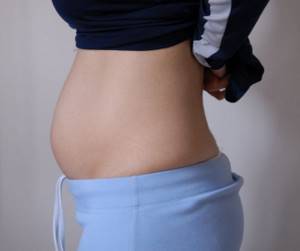
The approximate time for the start of abdominal growth is 16 weeks.
The size of your big belly
The baby has already begun to move less (about 12 times a day). With correct presentation, its head is in the area of your pelvis, while the fundus of the uterus is tilted forward.
The size of the belly seems too huge. The skin is stretched, perhaps a pigment stripe has appeared below the navel. In addition, the stomach itches and may peel because the skin on it has lost its elasticity.
You can alleviate your suffering in this regard with the help of special means: creams, ointments and oils. Well, after giving birth, these symptoms will disappear on their own.
Training contractions begin, the stomach gets hard. To relieve tension, you need to maintain basic peace.
This is what bellies look like at 39 weeks:

Important medical examinations and ultrasounds
A consultation with a gynecologist is necessary to assess the child’s condition and determine your readiness for the upcoming birth. As before, you will need to have your urine tested before each appointment. The doctor will conduct the usual examinations for you to measure weight, blood pressure, and the height of the uterine fundus. He will listen to the baby's heartbeat using a stethoscope and determine the baby's position by palpation. Cardiotocography (CTG) and ultrasound are performed according to indications.
Using an ultrasound at the thirty-ninth week of pregnancy, the location of the umbilical cord is determined. It can wrap around the baby's neck or body. This is not considered a global problem, since the umbilical cord is long (on average, about 60 cm, but it can be short) and can be easily removed after birth. The length of the umbilical cord cannot be determined by ultrasound. But thanks to ultrasound, the condition of the placenta is assessed and the stage of its aging is determined.
The ultrasound also shows that the baby’s intestines have dilated and are gradually filling with meconium (original feces). Particles of skin and lubricant are observed in the amniotic fluid.
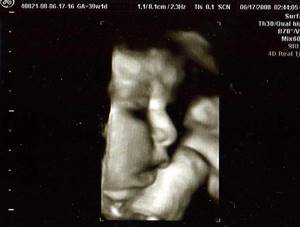
How many days/hours before birth does the plug come out?
Approximately how long it takes for the plug to come out before childbirth is a rather specific question. Some women do not even notice the moment of its passage and will never know what their mucus plug looked like, since it came out of the cervix simultaneously with the flow of amniotic fluid.
For others, the plug comes off a little earlier. Despite this, experts believe that the mucus plug should go away no earlier than 2 weeks before the expected date of birth. Read more about how the estimated due date is calculated →
The process of removal of the plug itself is one of the important precursors of labor, no less relevant than contractions and rupture of water. But, as we have already found out, the plug can come off a couple of hours before the onset of labor, or several weeks.
Therefore, it is better to clarify the situation and inform the doctor that the plug has come out - most likely, the specialist will conduct a vaginal examination and advise you to go to the prenatal department.
What to do if labor begins
Giving birth at 39 weeks of pregnancy is quite natural. The baby is completely ready to be born, he just needs a little help with this.
When labor begins, it is important to focus on proper breathing. Follow your doctor's recommendations, and also listen to your baby, monitor your body position and general well-being.
During contractions, it is better to walk rather than lie or sit. When contractions intensify, you need to take deep breaths and exhales. This will help save energy for pushing. You should start pushing only when the doctor gives the start. It's better not to think about pain.
Don't panic, focus only on the baby . Immediately after birth, he will be placed on your breast so that he can taste milk for the first time and calm down after his first stress in his life. This moment will become one of the most wonderful and unforgettable in your life!
How long will it take for labor to begin after the plug comes out?
It is difficult to say how many days before the birth the plug comes out. For most, rejection occurs at the thirty-eighth week. Moreover, there is no significant difference in how the protective mucus is released before childbirth in multiparous and first-time mothers. In both situations, this process occurs at approximately the same time and is accompanied by similar symptoms.
Experts will not be able to give a clear answer as to how many days later labor will begin if the plug comes out during pregnancy. Some people easily survive this for 2 or even 3 weeks; for others, labor can begin directly on this day.
The question of when to expect labor is resolved in a similar way if the plug comes out in parts. It's the same in this situation. The mucous lump may separate a couple of weeks before the long-awaited moment, or it may move away along with the amniotic fluid during contractions.
In any case, as soon as it becomes noticeable that the mucus has come out, you should contact the gynecologist and tell him about it. It is important to pay attention to the color of the cork. It should not be green or have a bad smell. If labor has not yet begun after the separation of the mucous lump, it is important to monitor the hygiene of the genital organs, monitor your well-being, and if you have regular contractions, go to the maternity hospital.
Our advice to expectant mothers
- All pregnant women in the last weeks are concerned about the issue of nutrition, because labor can begin any day. Just try to eat right, eating only healthy foods. You shouldn’t overdo it and abuse food, because adding weight now is completely useless. It is recommended to eat 5-7 times a day, but little by little;
- Take daily walks outdoors. This way the baby will feel much more comfortable;
- If there is slight malaise and fatigue, immediately try to lie down to rest;
- In a state of cheerful spirit and good mood, it will be much more pleasant for you to survive the last days of pregnancy;
- It is important to avoid prolonged pain when moving; only slight tingling sensations are acceptable. You should try to sleep and sit in comfortable positions. If the baby pushes a lot, this may mean that he is uncomfortable. In this case, you should change your position;
- In the last trimester of pregnancy, you have the last opportunity to calmly go with your husband to children's stores and buy something for the baby. Surely, through joint efforts, you will make a better choice than your husband later going alone for similar purchases. By the way, shopping can also improve your mood, which is especially important for you now;
- Many people are interested in the issue of sex in recent weeks. Listen to your body, because well-being comes first. If you feel a strong attraction and crave affection, then why not. Scientists have proven that in the female body, hormones released during orgasm have an analgesic effect. And male secretion perfectly prepares the uterus for childbirth, making the cervix more elastic. But it is worth remembering that you need to have sex carefully, avoiding painful sensations.
This material is for informational purposes only; before using the information presented, you must consult with a specialist .







